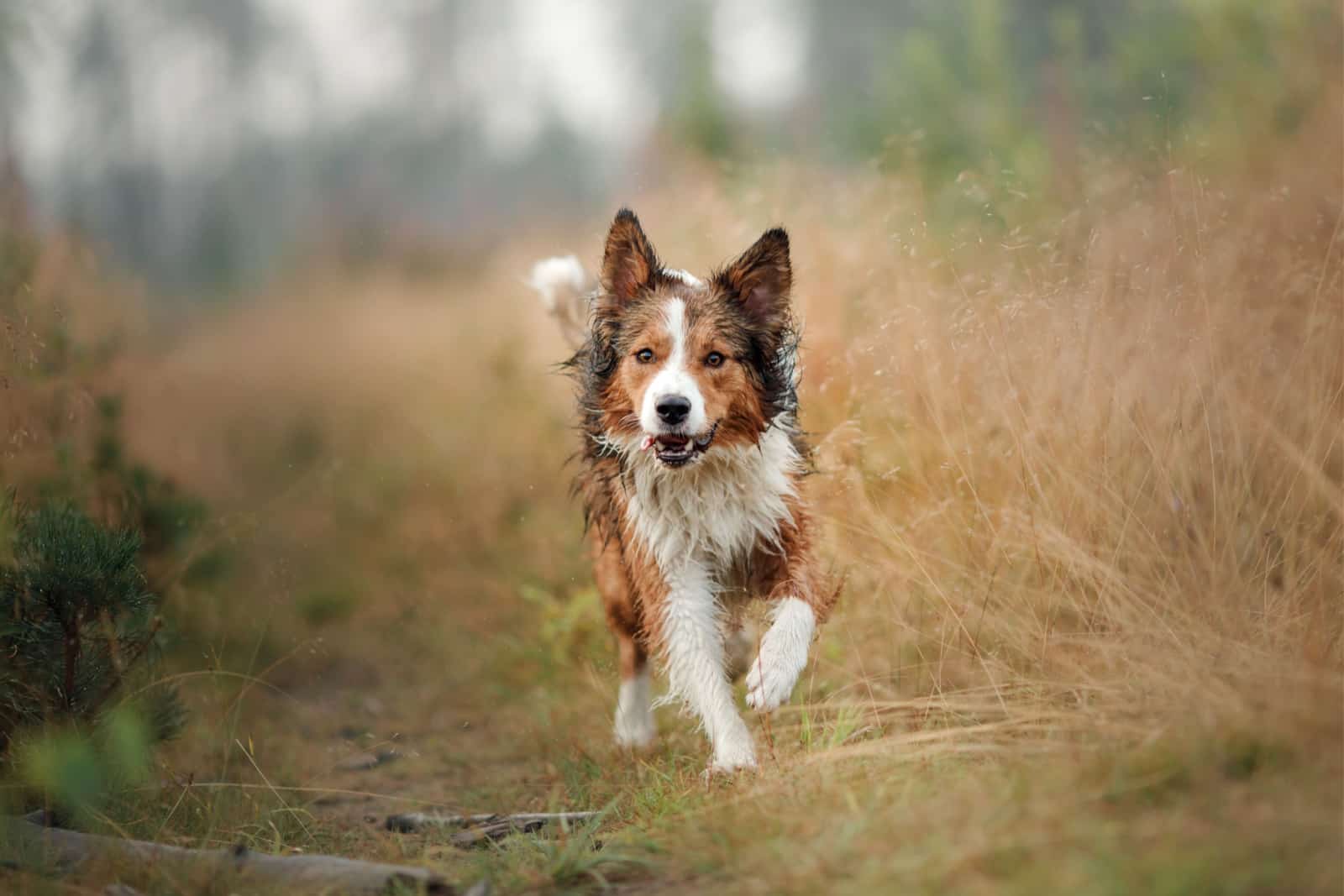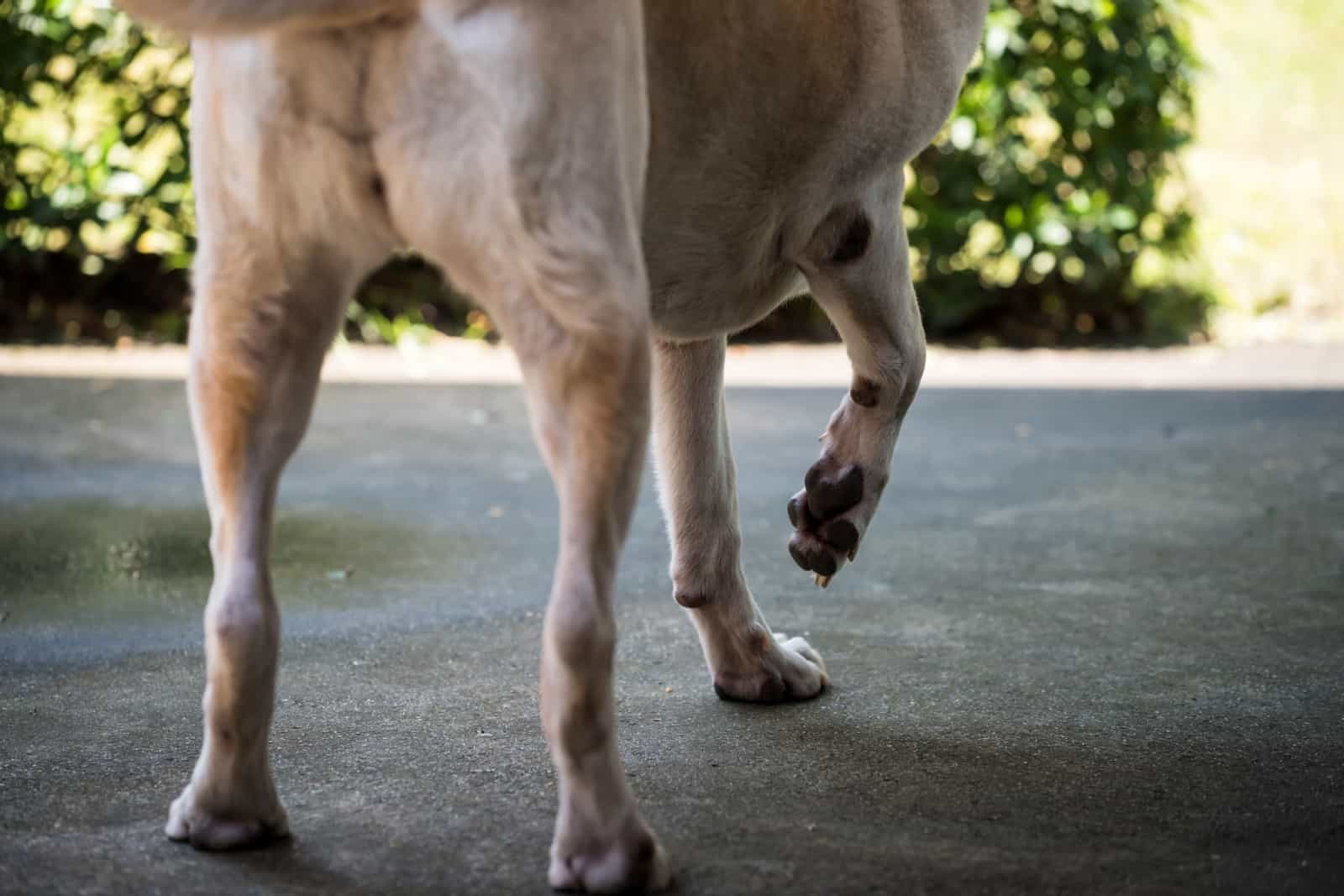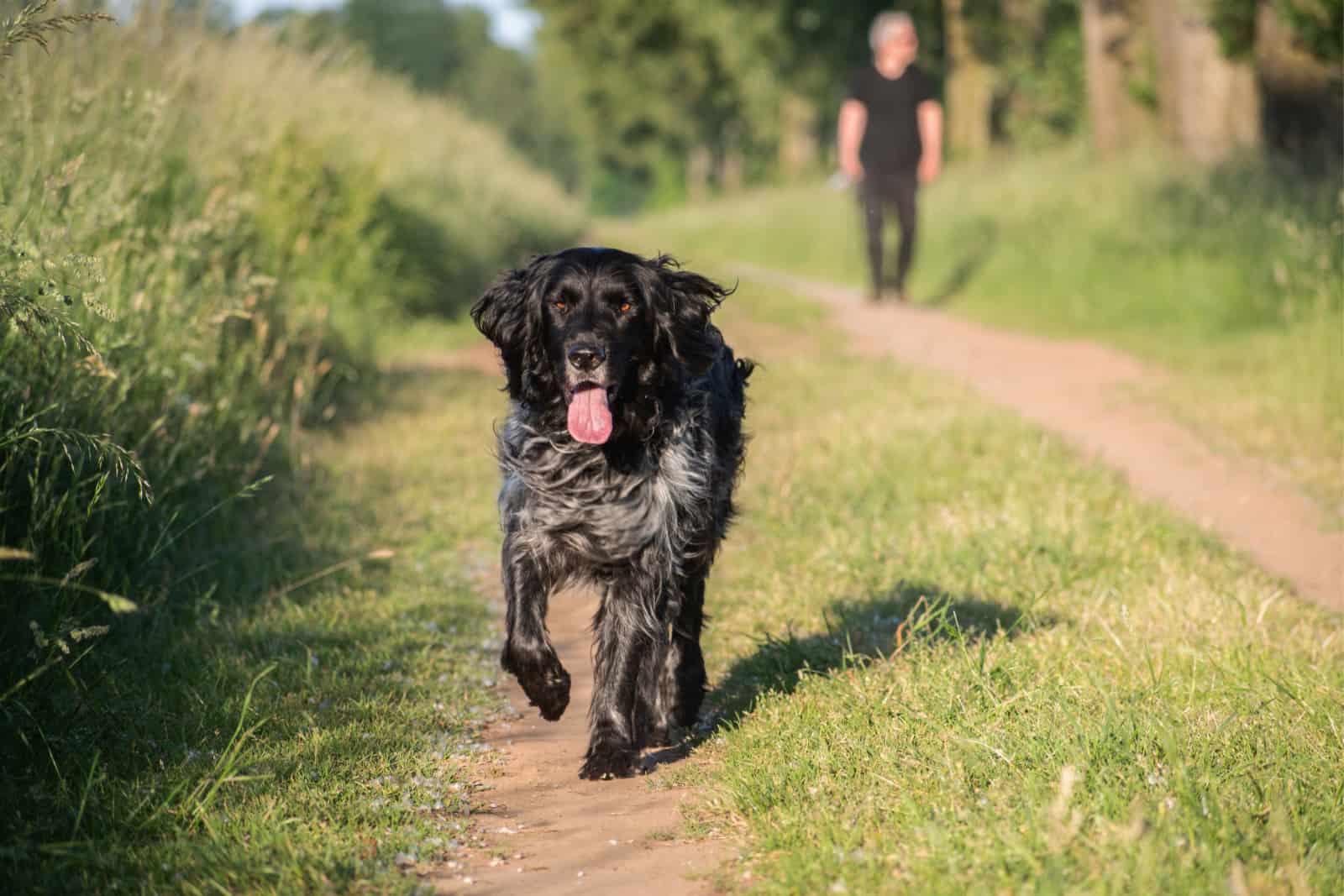Dog behavior can be a complex phenomenon at times, and it demands a deep study. There are a plethora of reasons that could cause strange behavior in a dog. Sometimes it is a medical issue, while most of the time, it’s just the way dogs are made.
The question of ‘‘Why is my dog walking sideways’’ is one of those never-ending mysteries, as there are numerous dogs that display this unusual phenomenon. Throughout this article, we will try to disclose eleven possible reasons for walking sideways or, in dog lingo – crabbing.
This issue is not a red flag by default, as it can represent a simple habit. Still, when you notice that your puppy is, indeed, walking sideways, you should try to find a cause at your earliest convenience.
Why Is My Dog Walking Sideways

Many dog owners sometimes wonder why their dogs are acting weird all of a sudden. A dog walking sideways, for sure, is one of those strange phenomena that couldn’t be explained in a simple sentence.
There is more than one cause for this unusual phenomenon. I have compiled a list of eleven possible reasons that narrow down the most common causes of crabbing. The list focuses on medical issues as well as on behavioral traits.
Walking sideways or, popularly known as crabbing, or sidewinding, is an unusual phenomenon by its nature, but at the same time, this dog habit is widespread in many dog breeds.
For instance, you can see crabbing in most Border Collies, Vizslas, Cocker Spaniels, Boxers, or even German Shepherds.
Most of the time, this is a harmless phenomenon that doesn’t affect your dog’s health. However, there are times when crabbing requires an immediate vet intervention, as it can be the symptom of a major health issue.
But first, let’s dig into the list and see which of these things your puppy is closest to!
1. It’s Just The Way They Are
Dogs’ crabbing can be a harmless phenomenon, as it occasionally happens in many dog breeds. It doesn’t necessarily represent a bad thing, as it’s just the way dogs are. For instance, many German Shepherds, or German Shepherd mixes, walk sideways.
In those cases, a dog’s body is set in an off-kilter manner during the walk. It may look like your dog’s balance is off, but it actually isn’t.
Still, if you have any doubts about your dog’s strange way of movement, you should pay a visit to your veterinarian. However, bear in mind that crabbing in some dog breeds, especially the large ones that happen to have long legs, is a common thing.
A dog walking sideways, if it happens as a result of some major injury or a disease, is usually accompanied by many other symptoms, such as lethargy, lack of activity, decreased movement, or severe pain.
On the other hand, if your puppy is walking or running sideways without any other symptoms – be at ease! It’s probably just a part of their sassy character.
2. Excitement

Sometimes, there are some strange ways by which your dog tries to show excitement or get your attention. If you have ever been struggling with issues such as ‘‘Why does my dog stand on me,’’ or ‘‘why is my dog walking sideways,’’ the answer might be – your dog is excited!
Showing excitement by crabbing is a common phenomenon, especially in younger dogs that still haven’t perfected their puppy manners. They just can’t wait until they approach you, so they feel the need to run as fast as they can in your hug!
Head tilt, strange dog moves, eye movements, or lifting their rear or front legs the wrong way are just some of the accompanying signs that your puppy is way too excited to walk normally.
Dogs’ crabbing is simply a part of their sassiness, and it shouldn’t be such a big deal. In fact, being sassy is a part of many dog breeds’ character.
Huskies, Chihuahuas, Dachshunds, Pomeranians, and Golden Retrievers are just some of many dogs that belong to a club of the sassiest dog breeds in the world. Having one of them as a life companion is a real pleasure, as they are never boring, and they will do anything for a little piece of attention!
3. Entering Adulthood
Puppies entering their juvenile age can be one of the explanations for walking sideways. This is especially related to large dog breeds, as some dogs have pretty long front and back legs by the time they turn six months of age while their bodies are still not fully grown.
Short bodies and long legs can cause crabbing, as puppies’ front feet and back feet can collide during the walk. They use crab walking in order to avoid unpleasant collisions and possible injury.
This is an instinctive phenomenon dogs use, as they feel more comfortable walking sideways. However, in these cases, help from professional dog trainers is highly recommended as dogs can adopt this habit as a common behavior, which can cause an off-balance in the future.
Losing the sense of balance is a pretty unpleasant phenomenon, but it can be fixed within a couple of weeks. Young dogs should be subjected to training at eight weeks of age, as a dog in heat is already a dog with well-adjusted manners that are hardly changed.
4. Disbalance Due To Ear Infections
There are many reasons for dogs losing their sense of balance. One of them is an ear infection. There are some dog breeds that are more prone to ear, or fungal infections, such as Basset Hounds or Labradoodles.
In these cases, it is necessary to subject your dog to a vet exam as soon as possible, as ear infections can lead to hearing loss, walking imbalance, or severe headaches.
If your dog’s gait is not as normal as it was before the infection, it probably means that your dog is suffering from a middle or inner ear infection.
This health problem can be extremely unpleasant, but luckily, it is easily treatable. Anti-inflammatory drugs or antibiotics will do it most of the time.
There are some common things that every dog owner could do in order to preventively check up on his/her dog. For instance, dog tongue color, skin, or ear checkups are some of those mandatory things that you need to do in order to prevent the occurrence of some major condition.
Furthermore, subjecting your puppy to regular veterinary care is the least you can do for your dog.
5. Hip Dysplasia

Hip dysplasia in dogs is probably one of the most common health issues in large dog breeds. It manifests throughout hip loosening, and it can lead to other issues.
This is a hereditary issue most of the time, and it is related to younger dogs. However, hip dysplasia affects older dogs, too. The most common symptoms of this condition are bunny walking, lack of activity, disinterest and lethargy, inability to move properly, and, consequently – crabbing.
Hip dysplasia has no fatal consequences, but its treatment should be timely. Otherwise, dogs that suffer from this condition can develop severe injuries, especially if their daily exercise routine is not as supervised as it should be.
Never let your dog with hip dysplasia jump excessively. Jumping movements can cause severe injury in their rear end, which, consequently, affects dogs walking sideways.
Also, senior dogs with hip dysplasia are generally unable to perform some complex exercise tasks, which is why you need to adapt the routine to them.
Hip dysplasia is generally treated by surgery. However, this procedure is not that cheap, as the standard price of hip dysplasia surgery revolves between $1200 and $2500.
The recovery process will take a few months, but eventually, your dog will heal, and it will be doing normal puppy activities in no time.
6. Vestibular Disease
Vestibular disease in dogs is an issue related to the aforementioned ear infections. However, ear infections are not the only cause of this disease. Vestibular disease is also caused by traumas, tumors, or by antibiotics.
You should know that this condition is not progressive, and it usually affects old dogs. It represents the sudden loss of balance in a dog, which can cause crabbing.
Even though it may sound scary in the first place, this health condition is generally not fatal, and it goes away by itself within several weeks. Things you can do to help your puppy heal are providing a safe, nurturing space for your puppy, as well as taking care of your puppy’s hydration.
If you notice crabbing in your dog during the walk, you should look out for further symptoms, such as head tilt, vomiting, nausea, circling in one direction, lethargy, lack of activity, and loss of appetite. All of these are the symptoms of vestibular disease, and they can help you identify it.
If you, however, notice that the overall condition of your puppy is getting worse, you should seek veterinary help as soon as possible. There always can be some complications, as each dog has a relative immune system that doesn’t respond to this disease the same.
7. Anal Gland Problems
Anal gland problems are an unpleasant phenomenon as they can be painful to your dog. There are many reasons for this condition, among which dermatitis, bad feeding habits, weight gain, allergies, and genetics are the most common.
Generally, the problem with anal sacs in dogs is that they get impacted due to the inflammation of the ducts. That’s why it is important to take care of your puppy’s feeding chart at all times, as bad nutrition or low-fiber foods can be a pretty serious issue.
On the other hand, obesity in dogs is never an option. Obese dogs are more prone to anal sac disorders than puppies that have a normal weight.
You should always be feeding your dog high-quality foods and stay away from table scraps. Also, adding healthy supplements to your puppy’s feeding chart is never a bad option. Still, for a well-planned feeding chart, you need to get your vet’s referral, as some puppies have dog allergies to certain ingredients.
When it comes to symptoms of anal sac disorder, the most common are: puppy diarrhea at night, scooting the rear end along the floor, licking, and a bloody stool.
As soon as you notice some of these symptoms, you should consult your vet about the treatment.
8. Foot Numbness

There are some lazy dog breeds that simply love being couch potatoes and laying on a dog bed for the most part of the day. The most popular lazy breeds are Pugs, French Bulldogs, Basset Hounds, Chow Chows, and Whippets.
Even though it may seem that being a lazy dog is an exclusive right of small to medium-sized dog breeds – that’s not true.
In fact, there are some large dogs that also enjoy not being called upon, as they love sitting on the couch or lying in a bed. Some of those dogs are St. Bernards, Newfoundlands, and Bernese Mountain Dogs.
The problem with these breeds is that excessive laziness can cause foot numbness, which can further lead to crabbing. However, the important thing to know is that this is not a serious issue, as foot numbness passes within a few minutes.
However, if foot numbness doesn’t go by itself, you should seek a veterinarian’s help, as it can be a symptom of some other disease.
Still, you should take care of your puppy’s daily activity, as even the laziest dog breeds need a certain amount of exercise during the day. Otherwise, they can face obesity, muscle atrophy, or cardiac disease.
9. Uncomfortable Dog Collars
Sometimes uncomfortable dog training collars and dog harnesses can be a pretty painful issue for your dog. In order to get the perfect dog collar for your puppy, you should always consult a professional dog trainer or a breeder for advice.
There are different dog collars for different dog breeds, which means that if you have a large dog, a collar for a small breed will probably be uncomfortable.
In these cases, dogs walking sideways will be a pretty common issue as they cannot move properly.
Furthermore, improper dog collars and harnesses can cause other discomforts, such as choking, fainting, spinal injuries, a hunched back, skin irritation, prolapsed eyeballs, and even damage to your puppy’s brain.
If you’re wondering why your dog is walking sideways, you should check if the dog collar your puppy wears is the right one. If not – replace it as soon as possible!
According to many professional dog trainers, dog harnesses are way better than dog collars, as they prevent spinal and neck injuries in dogs.
However, consultation with a vet or a breeder in the first place is highly recommended, especially if you’re a first-time dog owner and you don’t have sufficient knowledge on the matter.
10. General Leg Injuries

There are a plethora of leg injuries that could cause crabbing in your dog. Generally, leg injuries appear as a result of some sort of trauma or inadequate dog training.
If you notice symptoms such as a hunched back in a dog, lack of mobility, lethargy, pain in their front or rear end, or a puppy that has difficulty performing normal activities – they can be a sign of severe leg injury.
Other than crabbing and the aforementioned symptoms, there are clear signs that your puppy’s leg injury is serious. Obvious dislocation of a limb, an extremely hot leg, excessive swelling, and an unnatural position are red flags that require immediate vet intervention.
As a dog owner, you should be able to distinguish a minor leg injury from severe dislocation, breaking, or trauma. Generally, dogs that suffer major leg injuries won’t be able to even move properly, which is a cause for a vet check-up.
Dog crabbing in leg injuries never comes as a single symptom. It rather comes as one of at least two to three symptoms that clearly indicate something’s wrong. Being a responsible dog owner means being on alert when those symptoms occur.
11. Your Puppy Has A Dominant Leg
Humans and dogs share many common traits. Just like humans, dogs like to lay in the sun, they need attention and love, they go through the natural process of socialization, and they have a dominant leg.
On the other hand, walking sideways due to a dominant paw is just a force of habit, and it usually does not impact your puppy’s normal movements.
However, in some breeds, having a dominant leg means exclusively walking sideways, as some puppies cannot coordinate their movements properly. Even though this doesn’t sound as concerning as a leg injury, a dominant leg can represent a really complex issue.
Untreated incoordination due to a dominant leg can be a permanent issue. That’s why it is important to train your puppy coordination from an early age. If you don’t have sufficient knowledge on the subject, you can always seek professional help from certified dog trainers.
Also, implementing sporting activities can add to your puppy’s musculature and reinforce their overall body strength. Athletic puppies generally don’t have a problem with coordination, which means that breeds such as German Shepherds, Dobermans, or Rotties have a low chance of having a low sense of balance.
However, in most cases, this issue doesn’t represent a big deal. Most of the time, puppies will display crabbing when running excessively or if they are way too excited. Having a dominant leg doesn’t always mean that your dog will walk sideways.
FAQs

There is more than one meaning of a dog’s crabbing or sidewinding. Generally, this issue is not serious, and it represents a force of habit in a dog.
Furthermore, a dog walking sideways can mean excitement, as some puppies show their excitement with uncoordinated movements, such as crabbing, happy tail syndrome, or excessive jumping.
Still, walking sideways can be a result of a puppy’s body type, as there are some dog breeds prone to crabbing, such as German Shepherds, Border Collies, Vizslas, and Boxers.
On the other hand, crabbing can be a sign of a serious health condition, such as hip dysplasia, vestibular disease, or anal sac disorder. In these kinds of situations, immediate vet intervention is required.
Disorders such as hip dysplasia can lead to further injuries, which can cause a low-quality of life for your puppy in the long run. As a responsible owner, you should prevent that from happening.
Read Also: How To Get A Dog Unstoned: 7 Ways To Help Your High Dog
In some cases, first-time dog owners cannot tell if their dog is walking sideways. Typically, these situations are related to dogs’ sassiness, as sometimes it is really hard to say whether their uncoordinated walk is a way of fooling around or a natural disorder.
However, there are some obvious signs that even novice owners can notice. For instance, if your dog is showing signs such as crabbing, limping, staggering, or ‘‘favoring a side’’ in a movement, or if your dog is refusing to walk all of a sudden – this is a red flag that you can’t miss.
Typically, crabbing never comes as a single symptom of a major condition. If you notice other symptoms that we have already listed, then a vet visit is a must. However, if your puppy acts perfectly fine and it displays occasional crabbing – it’s most likely a behavioral trait.
Conclusion

If you’re in constant fear that your dog walking sideways means a bad thing – you should subject your puppy to a veterinarian exam. However, as we listed out in this article, crabbing can be a simple behavioral trait of your dog.
The important thing that every dog owner should know is that crabbing never comes as an independent symptom in major health conditions. It generally comes as in a group of other more progressive ones, such as severe pain, inability to move properly, lethargy, loss of appetite, or a limb dislocation.
Otherwise, it’s just a simple force of habit that you need to adapt to as your puppy’s normal behavior.
Read next: Why Is My Dog Restless At Night? Dog’s Behavior Explained















